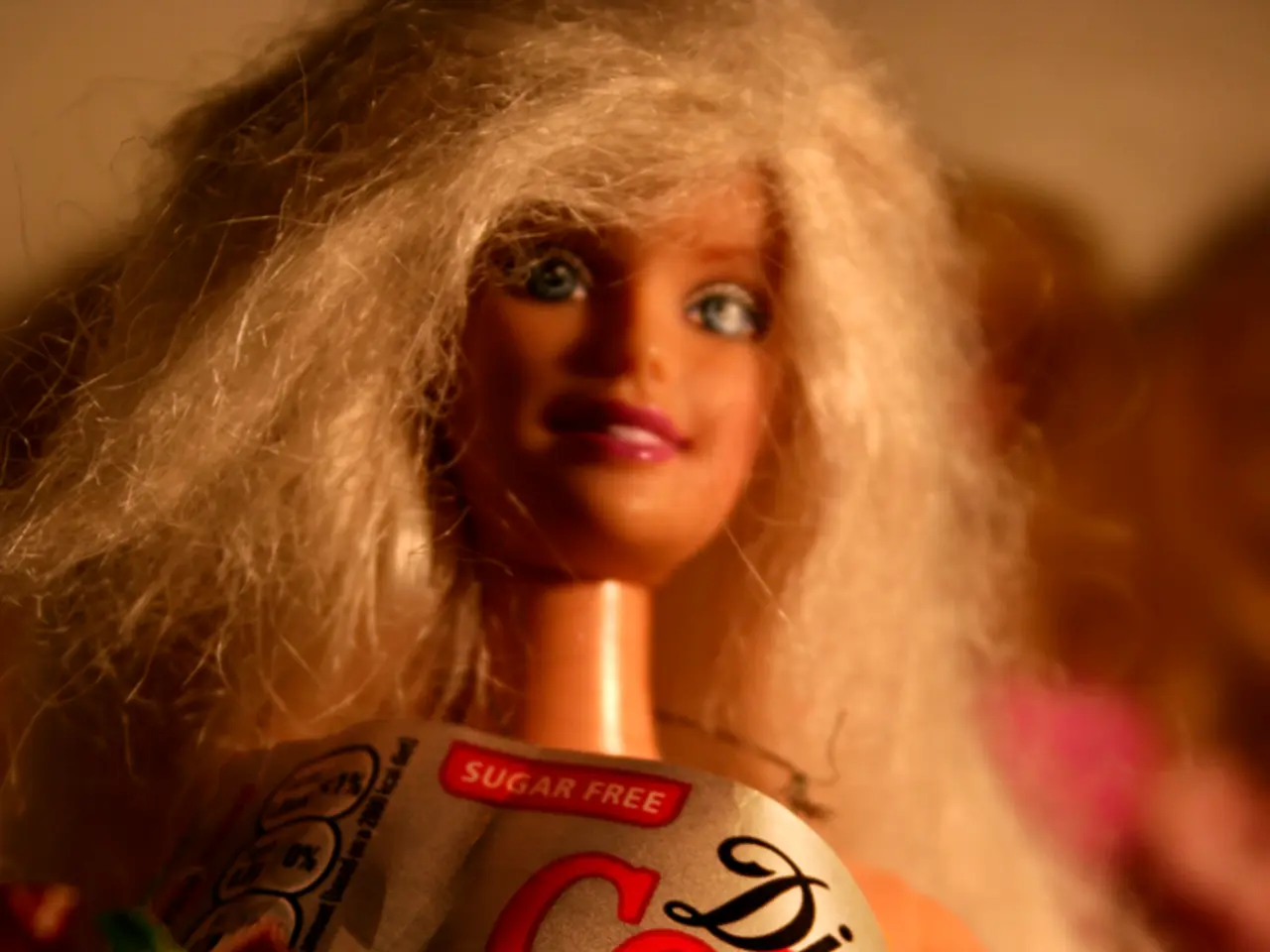Multitudes of child individuals globally grapple with Type 1 diabetes, a malady. A new Barbie was introduced, sharing the same health condition.
In a groundbreaking move, Mattel has introduced a new Barbie doll with type 1 diabetes, marking a significant step in the toy industry's efforts to increase representation and raise awareness for chronic health conditions. This innovative addition to the 2025 Barbie Fashionistas collection is set to inspire, educate, and foster a more inclusive environment for children with type 1 diabetes and those around them [2][4][5].
The new doll, a chic blue polka-dot figure with a ruffled miniskirt, chunky heels, and an insulin pump, is part of Mattel's Fashionista line, which includes over 175 different looks, ranging from various skin tones, eye and hair colours, to dolls with hearing aids, a cane, a prosthetic leg, and vitiligo [3]. This latest addition to the collection is equipped with a continuous glucose monitor on her arm, an insulin pump attached to her waist, a cell phone with an app displaying glucose readings, and a light blue purse to hold supplies and snacks [1].
Emily Mazreku, director of marketing and communications at Breakthrough T1D (formerly known as the Juvenile Diabetes Research Foundation), played a pivotal role in the doll's design. Mazreku, who has type 1 diabetes herself, was pleased with the opportunity to bring this doll home for her 3-year-old daughter, as it allows her to see a positive, relatable role model who shares her mother's condition [5].
The collaboration between Mattel and Breakthrough T1D extends beyond the creation of this new doll. The doll's launch was timed to coincide with the Special Diabetes Program, a program that provides funding for diabetes research and care, which is set to expire in September [6].
The introduction of this doll is not only a step forward in representation but also a move towards normalising type 1 diabetes. By including a doll with visible type 1 diabetes representation, Barbie helps foster empathy among peers and provides children with the condition a positive, relatable role model [2][5].
The doll's significance extends beyond just children with type 1 diabetes. Dr. Sian Jones, co-founder of the Toy Box Diversity Lab at Queen Margaret University in Edinburgh, Scotland, believes that playing with dolls that have disabilities can reduce systemic inequality for disabled people [7]. This theory aligns with the theory of mirrors and windows by Rudine Sims Bishop, a professor emerita of education at Ohio State University, which suggests that having diverse characters in books is beneficial for all children, helping them see themselves mirrored and building empathy for others [8].
In 1997, Mattel launched its first doll with a disability, a friend for Barbie called Share-a-smile Becky, who used a wheelchair [4]. However, challenges persisted, such as the inability of Becky's wheelchair to fit through the doors of the Barbie Dream House, a situation many people with disabilities encounter in real life [9].
Dr. Jones, who lives with cerebral palsy, started incorporating disabled dolls into school curricula when few were available for purchase, often having to make them herself [10]. Now, with companies like Lego and Mattel offering a wider range of options, the landscape for inclusive play is changing, providing children with the opportunity to learn and grow in an environment that reflects the diversity of the world around them.
- Science has played a crucial role in the understanding and management of medical-conditions like type 1 diabetes.
- The new Barbie doll, with type 1 diabetes, is a significant stride in the health-and-wellness industry's drive for inclusion.
- Fitness-and-exercise, a vital part of managing type 1 diabetes, is not directly represented in the new Barbie doll but encourages discussions about the importance of an active lifestyle.
- sexual-health and family-health are essential aspects of overall well-being, and the new Barbie doll's introduction opens conversations around these topics.
- Mental-health is equally important, and the doll's presence might foster empathy among children, aiding in the understanding of chronic-diseases like type 1 diabetes.
- Mens-health, a lesser-discussed topic, should also benefit from increased representation and awareness surrounding medical-conditions such as type 1 diabetes.
- Skin-care is another essential aspect of personal care, and the new Barbie doll showcases a bubbly miniskirt and chunky heels, promoting self-care and self-expression.
- Therapies-and-treatments for type 1 diabetes, like insulin pumps and continuous glucose monitors, are accurately represented in the new Barbie doll.
- Nutrition plays a crucial role in managing type 1 diabetes, and the doll's light blue purse suggests the importance of carrying snacks and supplies.
- Womens-health is an essential focus area, and the new Barbie doll's introduction encourages representation and open discussions about various medical-conditions.
- Parenting becomes more manageable with adequate information and representation, as provided by the new Barbie doll with type 1 diabetes.
- Medicare coverage is a critical aspect of managing chronic-diseases like type 1 diabetes, and advocacy around representation in toys can extend to discussions on healthcare accessibility.
- CBD products, often used for pain management in chronic-diseases, have not been directly addressed in the new Barbie doll, but the momentum for inclusivity opens doors for discussions around diverse treatments.
- Cooking, an essential life skill, and healthy-cooking, an integral part of managing type 1 diabetes, are not directly represented in the new Barbie doll but can spark discussions about the importance of balanced diets.
- Lifestyle, which includes health, work, and personal relationships, is influenced by representation and normalization of chronic-diseases like type 1 diabetes.
- Fashion-and-beauty, an industry that caters to diverse tastes and needs, benefits from increased representation in toys like the new Barbie doll with type 1 diabetes.
- Food-and-drink, a vital part of everyday life, can be discussed in the context of managing type 1 diabetes, thanks to the new Barbie doll.
- Family-dynamics are affected by chronic-diseases like type 1 diabetes, and the new Barbie doll can serve as a valuable conversation starter.
- Home-and-garden, a space where life's essentials are cared for, can be seen in the new Barbie doll's light blue purse, symbolizing the need to carry supplies and manage type 1 diabetes effectively.
- Recipes, an ancestral tradition, can be modified to accommodate various dietary needs, as exemplified by the need for healthy-cooking in managing type 1 diabetes.
- Relationships, an integral part of life, can be fostered through empathy and understanding, as encouraged by the new Barbie doll with type 1 diabetes.
- Pets, a common part of many families, can offer comfort and companionship to children with chronic-diseases like type 1 diabetes, and their inclusion in discussions can support holistic health.
- Travel, a way to explore the world and broaden perspectives, becomes more accessible when managing chronic-diseases like type 1 diabetes, with the right information and support systems in place.
- Cars, a practical aspect of everyday life, play a role in various careers, including car-maintenance and career-development.
- Education-and-self-development, key factors in personal-growth, are aided by increased representation and awareness surrounding medical-conditions like type 1 diabetes.
- Mindfulness, a practice for mental well-being, can help manage stress and anxiety associated with chronic-diseases like type 1 diabetes.
- Shopping, an essential part of daily life, can promote inclusivity by supporting brands that offer diverse products, like the new Barbie doll with type 1 diabetes.
- Car-maintenance, a valuable skill, can be linked to the technology used in insulin pumps and continuous glucose monitors.
- Productivity, a crucial aspect of career-development, can be enhanced through effective diabetes management, as represented by the new Barbie doll with type 1 diabetes. Additionally, electric-vehicles, a sustainable and growing industry, can support career-development by offering opportunities in job-search, goal-setting, skills-training, and sports, such as football, soccer, WNBA, baseball, hockey, golf, European leagues, basketball, NCAABasketball, MLB, NHL, racing, premier-league, tennis, and auto-racing.





